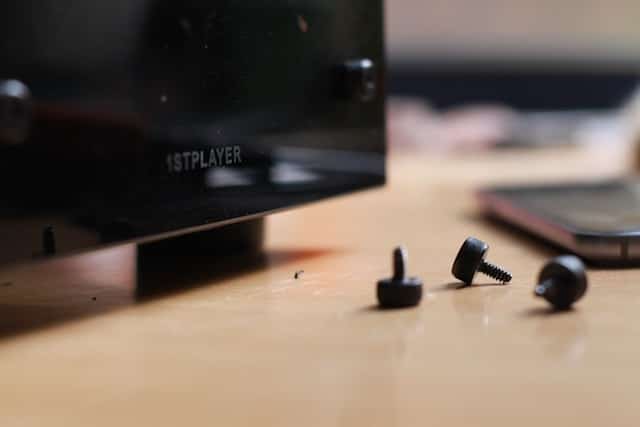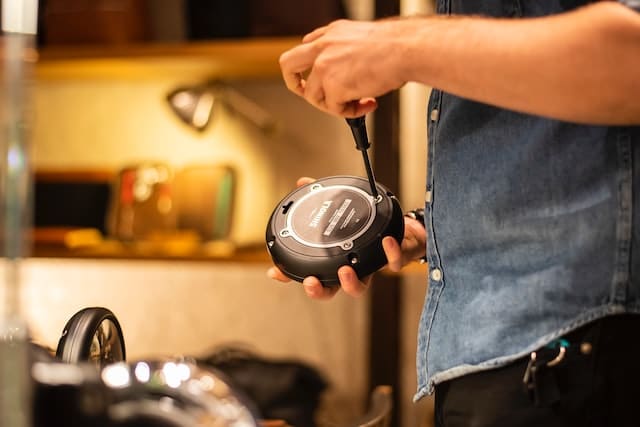Introduction – Opening Up And Upcycling Electronics
Electronics are crucial to maintaining the quality of life we have become accustomed to in today’s society. We rely on them for communication, entertainment, work, and even simple tasks like keeping track of our daily schedules.
At ShrinkThatFootprint we are fans of reusing and upcycling equipment and electronics belongs to that category. Old electronics can be repurposed with a little help, including getting into the insides and replacing broken components.

Opening them up is a problem sometimes made worse by very tight old screws. This is when you want to learn how to loosen tight screws on electronics.
When we want to upcycle or fix our electronics on our own we might get confused about how to loosen tight screws on electronics. Different types of screws are used for holding different parts together. So it is essential to know about different screwdrivers and how to use them to loosen or tighten the screws. There are many ways to loosen tight screws on electronics.
How To Loosen Tight Screws On Electronics?
If you’re like most people, you probably have a few electronics around the house that have screws that are difficult to remove in the course of opening them up because the head of the screw is stripped out meaning the screwdriver has no slots to “catch” or you have a situation where rust has developed around the screw that makes it very hard to get out.
While it’s tempting to just grab a pair of pliers and give it a good yank, this can damage the screws and make them even harder to remove. Instead, try the following tips. What we will describe here is a progressive process, after each step, gently try to remove. If it doesn’t work, move onto the next step.
First Step: Spray Lubricant Onto The Screw
This step is very important because it will make every following step much easier. Now first if it’s just rust that you’re dealing with a screw that’s stuck then you want to use something like WD-40 a spray-on lubricant.
The liquid will penetrate down into the screw and many times will loosen up that rust and allow you to get that stuck screw out. You just need to spray enough that the fluid will trickle down to the base.
When dealing with electronics, you should use a fast-drying or non-conductive lubricant to avoid damaging the device.
Second Step: Use a Rubber Band – For Large Screws Only
For larger screws, sometime’s there’s no need to break out the screwdriver if you’re trying to loosen a tight screw on an electronic device. All you need is a rubber band. Just stretch the rubber band over the head of the screw, and then press down with your thumb while you turn the screw counterclockwise.
The friction from the rubber band will help to loosen the screw, making it easier to remove. In addition, using a rubber band is much less likely to damage the surrounding area than using a screwdriver or other tool. So next time you’re struggling to loosen a tight screw, reach for a rubber band instead.
This technique is more suitable for larger screws, as it might not be effective on the tiny screws commonly found in electronics.
Third Step: Gently Knock The Screw Head With A Hammer Or The Handle Of The Screwdriver
After applying WD-40, you may find its still difficult to loosen it without stripping the head. The best way to loosen a screw is to gently knock the screwdriver head with a hammer.
The shock from the impact will loosen the grip of the screws and make it easier to remove them. Do not use a heavy duty hammer because that will damage the electronics.
Try to the screwdriver head with the flat side of the hammerhead. Also don’t use the hammer’s claw end, as this could damage the electronics. With a few gentle blows, the screw should become loose enough to remove by hand. If not, repeat the process until the screw loosens.
This should be done very carefully to avoid damaging the electronics.
Fourth Step: Cut A New Slot Into The Screw Head
Now we’re getting more serious. If you find that these methods are not getting the necessary grip between screwdriver and screw head, it’s time to add a deeper slot. Make sure the electronic item is fixed really well.
You will also need the screw head to be poking slightly out otherwise there’s no way to make the screw head slot deeper. Take a very thin file and using the filing edge, widen and deepen the screw head groove. You just to increase the depth a little bit and try the screw driver again.
This can be effective for stripped screws, but it should be done very carefully to avoid damage. You’ll need a tool such as a Dremel for this, and it’s not suitable for small screws.
Fifth Step: Glue and Nut Technique
The Glue and Nut Technique is a great way to loosen tight screws on electronics. First, take a small piece of glue and apply it to the head of the screw. Next, take a nut and screw it onto the glued screw. Finally, use a pair of pliers to twist the nut in the opposite direction of the screw.
The added friction will help to loosen the screw, making it easier to remove. This technique can be used on various screws that are difficult to reach or stuck in place. With patience and perseverance, the Glue and Nut Technique can help you get those pesky screws out in no time.
This is mostly useful for larger screws and might be difficult to apply on the small screws in electronics.
Sixth Step: Use a Screw Extractor
This is a special tool designed to remove stuck or stripped screws. They come in various sizes and can be very effective.
Seventh Step: Heat and Cold
This method involves using a soldering iron to heat the screw and then cooling it quickly. The rapid expansion and contraction can help break the bond. But, it’s important to be extremely cautious because the heat can easily damage electronic components.
Eighth Step: Use Pliers
If the screw head is protruding enough, you might be able to grip it with a pair of needle-nose pliers and turn it that way. This can be effective, but again, care must be taken not to damage surrounding components.

What Can I Use Instead Of A Screwdriver?
A screwdriver is an essential tool in many homes and workshops. Its primary function is to drive or remove screws, but sometimes we find ourselves without one at a critical moment. What can you use instead of a screwdriver?
- Coins: For less tight screws, you can sometimes use a coin (like a penny or a quarter) to turn flat-head screws. Though it doesn’t offer much torque, it can be a quick solution.
- Butter Knife: A flat butter knife might fit into the slot of some screws. However, be cautious using this method as applying too much pressure can damage or bend the blade. Also, ensure it’s not a knife you’re especially fond of.
- Pliers: If the screw is protruding slightly, you can grasp its head with pliers and try to turn it.
- Hammer: A hammer is primarily for driving in nails, but the claw end of a hammer can sometimes assist with removing protruding screws. Be gentle to prevent damaging the surface around the screw.
- Flat Metal Clip: In some situations, a flat metal paperclip or a small flat metal piece can be employed to turn tiny screws, like those in eyeglasses.
Warning: Avoid using thin, sharp blades like those of utility knives or exacto knives as a screwdriver substitute. These can easily snap under pressure, posing a risk of injury.
In most cases, a screwdriver is the best tool for the job. However, some tasks are better suited for other tools.
In Conclusion
In conclusion, progressively loosening the screw with the above methods and using the right screwdriver can make all the difference when trying to loosen a tight screw. Whether using a traditional screwdriver or an alternative tool, it’s important to exercise caution and patience. With a little effort, you should be able to get that stubborn screw loose in no time.
